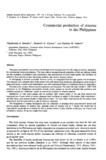Commercial production of Artemia in the Philippines
Share
Abstract
This paper summarizes experiences and findings in the development of a tidal saltpond system, integrated for commercial Artemia production. The basic rules of successful pond production of fish and shrimp, which are the exclusion of predators and competitors, the maintenance of good water-quality, the provision of sufficient food and the proper harvesting method, also govern Artemia culture.
In attempting to achieve successful Artemia culture, an integrated flow-through system was developed. The necessity for a detailed plan of the ponds with well-determined elevations, advantageous positioning of gates and canals, correct pond orientations, and well-constructed dikes is considered crucial to integration.
Procedures for proper Artemia pond preparation are discussed. The relatively high rainfall (1 200-2 000 mm/year) in the Philippines necessitates reliable screen designs to exclude potential fish predators and overflow devices for freshwater runoff, to extend the duration of Artemia seasons.
Installation of tidal plane gauges and an auxiliary high volume pump in the salt farm permits the manipulation of water levels to ensure adequate water exchange or supply to the system, high evaporation : salt bed ratios, and optimal depths of high salinity water. The daily water requirements for the system were determined and its relationship to salt production examined.
The integration of organic fertilization and the utilization of drainage from semi-intensive prawn and shrimp ponds enabled to achieve high standing crops of Artemia (up to 7 tonnes wet weight/ha) in high-salinity ponds that are unsuited for fish or prawn culture. Under optimal conditions, the Artemia cyst production reaches 20 kg dry weight/ha/month.
Description
This paper is Contribution number 171 of the SEAFDEC Aquaculture Department.
Suggested Citation
Jumalon, N. A., Estenor, D. G., & Ogburn, D. M. (1987). Commercial production of Artemia in the Philippines. In P. Sorgeloos, D. A. Bengtson, W. Decleir, & E. Jaspers (Eds.), Artemia Research and its Applications (Vol. 3. Ecology, Culturing, Use in Aquaculture, pp. 231-238). Wetteren, Belgium: Universal Press.

